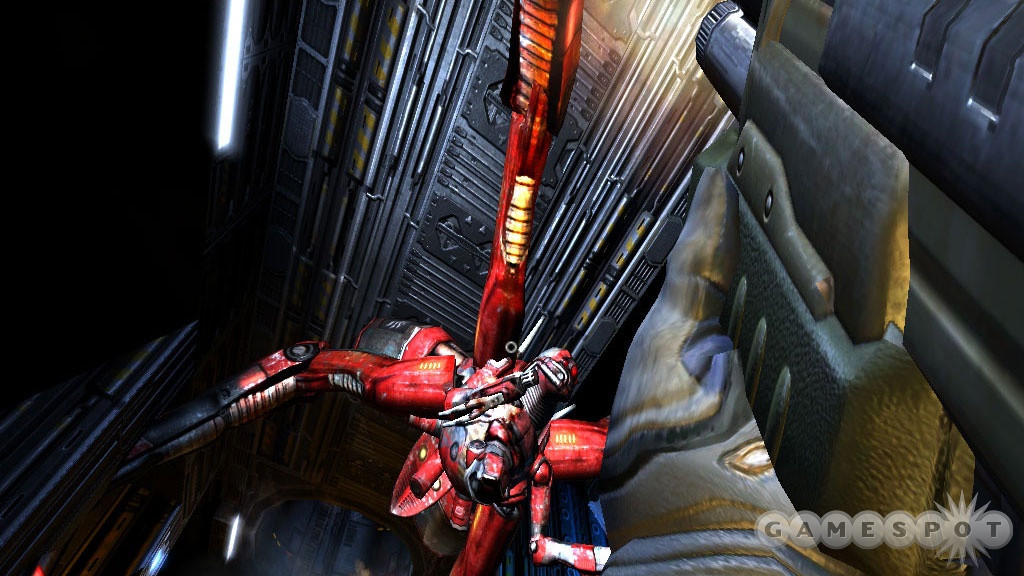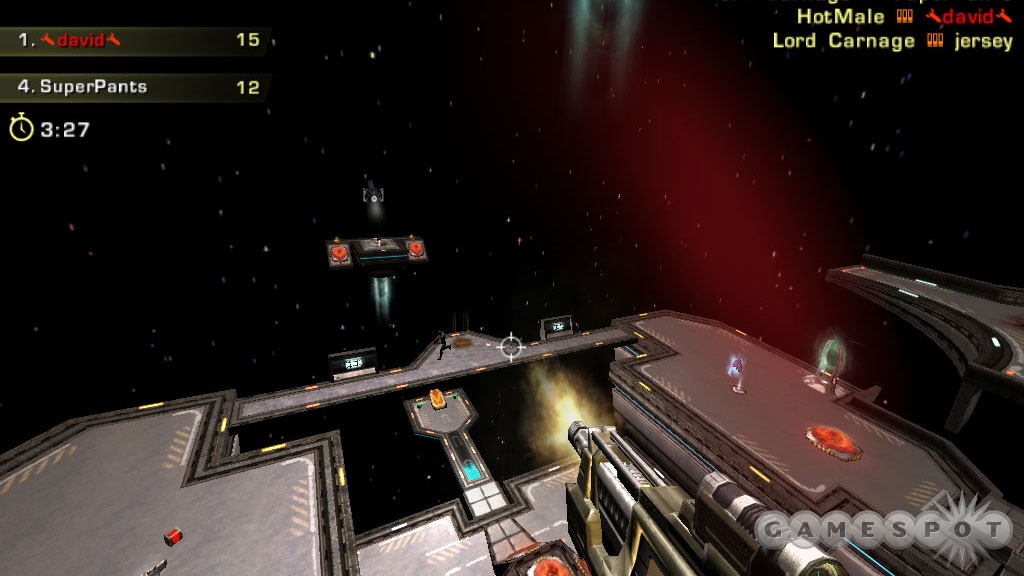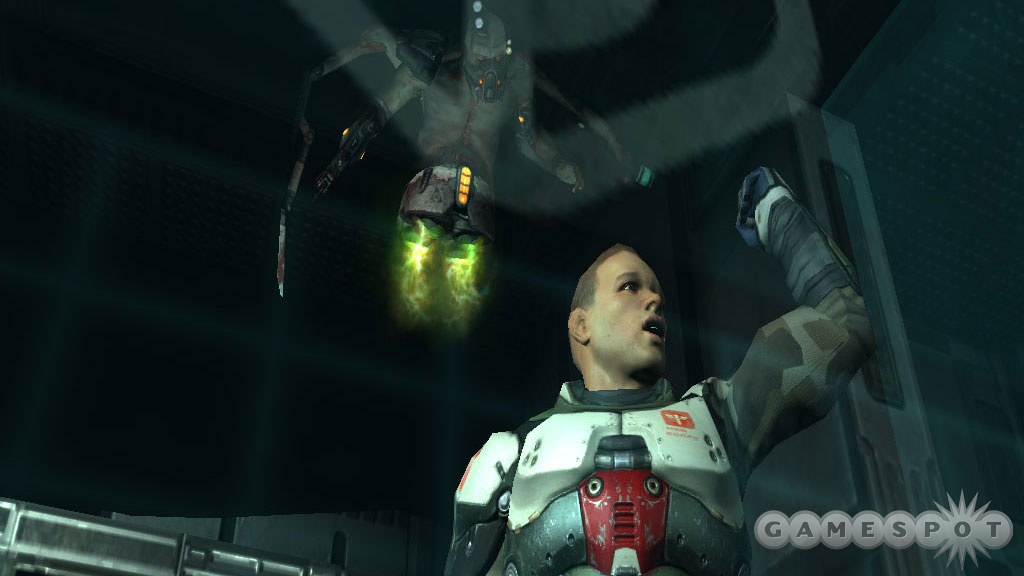While Doom was the game that would make id Software a gaming-household name in the early '90s, over the years, the company shifted its focus away from the Doom games. As PC hardware and 3D acceleration became better and better, id became much more focused on engine development. Those engines were the underlying technology that powered the games in the Quake series, which began in 1996. Quake was among the first PC first-person shooters to let you take your multiplayer matches onto the Internet, and over the years, the series has become synonymous with great technology and exciting multiplayer. Now, in 2005, the roles of id's games have reversed a bit. The company's most recent engine is the one built for Doom 3, and Quake 4 runs on this same engine. Furthermore, Quake 4 wasn't even developed by id internally; it instead outsourced game development to the capable minds at Raven Software, who have turned in a fantastic-looking game with a great single-player campaign. The multiplayer, however, is underwhelming.

The three previous Quake games have all had very little to do with one another. The first game's story almost felt more like a retelling of Doom, dealing with inappropriately opened portals that spew out all sorts of horrific demons. Quake II ditched that storyline in favor of an Earth-versus-alien conflict that had you crash-landing on the alien homeworld in search of revenge. Quake III Arena was multiplayer focused, with no true single-player storyline other than that a wide collection of warriors--some taken from the Doom and Quake games--had been pulled out of their own timelines and into this futuristic battle arena. Quake 4 doubles back and picks up where Quake II left off. That nameless space marine from Quake II has apparently killed the Makron, the leader of the Strogg forces, and now it's up to you to get in there and try to finish the job. But, of course, things aren't quite what they seem.
In Quake 4, you play as a space marine named Matthew Kane, who has recently been assigned to Rhino Squad. In keeping with first-person shooter storyline tradition, Kane doesn't speak, but the marines around you will more than make up for the lack of chatter coming out of Kane's lips. You're the new guy, and some of the squad's even betting that you won't even survive for one day. With the Makron assumed dead, your squad is taking part in an operation to take advantage of the disarray and mop up the rest of the enemy forces on the Strogg planet. But your drop ship gets hit and comes down hard, killing a large chunk of your squadmates at the opening of the game. From there, you'll pull yourself up out of the muck and get down to business.
Eventually, your squad will get extracted back to a capital ship for reassignment. Here, you'll get to explore the ship, similar to how you could explore Voyager in Raven's Elite Force games. Then you're back out on a new mission designed to disrupt the Strogg communication network. And the story continues from there. While the story itself isn't particularly gripping, it's designed well enough to keep you interested in what's happening. There's also a potentially interesting plot twist in the game that, unfortunately, was revealed by id Software almost immediately, when the company first started talking about and showing off the game. We won't repeat it here, in case you've managed to stay away, because we have to imagine that the twist would have been a lot more interesting if you didn't see it coming. Just know that a few interesting things happen in the game, but they don't totally change the way the game is played or anything like that.
For the most part, Quake 4 is a standard, straightforward shooter in its single-player mode. While the minute-to-minute objectives might not be the most interesting thing in the world, the game's combat is generally pretty satisfying. It's almost as if Raven set out to prove that the Doom 3 engine could do more than just constantly try to surprise you, one enemy at a time. That's not to say that Quake 4's hallways are littered with angry enemies, but Quake 4 is definitely a much more hectic game than Doom 3 ever was. While you'll still deal with a lot of shadowy areas, this is less about making you jump out of your seat and more about running and gunning. When matched with the game's amazing graphical design, the single-player becomes an exciting thrill ride that, on the default difficulty setting, should take you somewhere around 10 to 15 hours to complete.

In the end, first-person shooters still come down to their armory. In Quake 4, you'll be armed with a fairly standard collection of weapons that may have originated in the Quake II universe--but that doesn't mean they're all identical. You'll start the game with only a blaster, which has infinite ammo and can be charged up for a more powerful shot. But this quickly gives way to the machine gun, which is versatile enough that you'll probably be relying on it throughout the entire game. That's mostly because the machine gun has a flashlight mounted on it. Even though the game isn't trying to spook you by having enemies jump out of the shadows, seeing better is always a good thing. Plus, lighting up some dark corners is a good way to find extra ammo and armor.
You'll eventually get a shotgun, a grenade launcher, the energy-powered hyperblaster, a rocket launcher, the railgun, a nailgun, the lightning gun, and so on, up to the game's version of the BFG, the dark matter gun. Right off the bat, most of these weapons aren't much handier than the stock machine gun. Reloading the shotgun takes too long, the nailgun has a long, chaingun-style spin-up time, and so on. Along the way, you'll run into marines who can upgrade your weapons. Your shotgun will eventually be modified to be a clip-fed weapon, making reloading a snap. The nailgun gains the ability to lock onto targets and shoot homing nails that make it behave almost identically to the needler from Halo. The lightning gun upgrade makes it chain off and attack other enemies standing near your target. The hyperblaster upgrade makes its shots bounce off of walls. And the railgun gets a power upgrade that makes it much more useful. The rocket launcher gets an auto-loader that loads up three rockets at a time, letting you fire them off in faster succession. While you'll still rely on that machine gun in a lot of situations, most of the weapons come into their own later in the game, giving you some good, tactical decisions to make as you fight.

You'll also fight alongside some other marines at various points in the game. While they aren't perfect, they do seem to fight a lot better than you'd expect from squadmates that are completely out of your control. They also seem to take a lot more damage than you'd expect, but that doesn't mean they're invincible. If you let one of the game's key characters catch too many hot ones, they'll go down, and you'll lose as well. Incidental marines that you encounter along the way, however, are free to die without any penalty. Some marines are flagged as medics or engineers, who will heal you and repair your armor, if asked. Fighting alongside other marines brings some variety to the game, as do the game's vehicles. You'll get to pilot a hovertank and a mech, and at one point, you'll work the gun on a tram to defend it from enemy attackers. The vehicles heal themselves over time, just like the shield system in Halo, which make these sequences very easy. Still, rolling around in the game's vehicles and blasting stuff is still fun, and the sequences are short enough to not get in the way.
While the single-player doesn't feel like a throwback, firing up the multiplayer side of the game is like going on an archaeological dig. As you dig, you'll unearth a take on Quake III Arena's multiplayer for up to 16 players. While the goal was clearly to duplicate Quake III Arena's fantastic deathmatch, the feel of the game isn't quite right, which, aside from the inclusion of a few maps from previous Quake games, doesn't manage to pull off the nostalgic feel it was probably going for. Instead, it just sort of feels like a relic, delivering the barebones standard modes of deathmatch, team deathmatch, one-on-one, and two versions of capture the flag.
That's not to say that the multiplayer isn't exciting. It's fun, it's fast-moving, and deathmatch is the star of the show, but it's also nothing you haven't seen and played to death already. While all of this stuff was fantastic in 1999, it's a little stale now. The weapons from the single-player side are included here, but they're streamlined to not force you to reload your weapons. The level design is full of Quake III-style jump pads, and you'll have the same sort of air control that you had over your airborne combatant in Quake III. Even the announcer sounds virtually identical to the one from Quake III, and makes the same kind of commentary you've already heard a billion times. The frantic multiplayer has its moments, but it's disappointing how little the multiplayer has evolved.
In Doom 3, the graphics were the star of the show and basically made the game's whole theme possible. Without those high-quality lighting and shadow systems, how could hell's demons hop out at you from the darkness? Quake 4 has an entirely different theme to it, but it still makes fantastic use of the Doom 3 engine. Exploring Stroggos is exciting on its own, just because the game is full of interesting areas that look absolutely amazing. The design of the various alien areas get to be more and more breathtaking as you work your way deeper and deeper into the game. The models of the other marines on your adventure look great, too. Many of the enemies are updated takes on foes found in Quake II, but as you'd probably expect, they look a whole lot better now. It also has support for widescreen monitors, but it doesn't seem to actually support widescreen resolutions. All of this graphical prowess comes at a price; you'll need a pretty stout machine to run it well. Machines that just barely meet the game's minimum requirements will get a reduced version of the experience that runs smoothly, but the scaled-back detail detracts from the experience.
Quake 4 has great sound that helps highlight the experience. The weapons sound appropriately tough, which is always key for a shooter. But the game is much more than the sounds of weapons and explosions. The voice work is sharp and believable, and helps give a little more life to the marines around you. However, sometimes you'll hear different radio chatter repeat frequently, especially if you're taking your sweet time getting to that next objective. Also, sometimes you'll get radio transmissions in the middle of a fight, and the voice gets drowned out. Fortunately, that speech is never too important. The game's music is understated, but fits in with the atmosphere. There are even a few musical stabs in the game that play when you open a door and see an enemy on the other side, almost as if it's attempting to poke fun at Doom 3's constant "what's behind the next door?" scare tactics.
Overall, Quake 4 is kind of a weird case. The single-player is great fun, but the uninspired multiplayer leaves a lot to be desired. The end result feels like two different games. The single-player has a straightforward, no-nonsense approach to it that makes a great showpiece for the Doom 3 engine, while the online portion feels like it fell out of a time warp. If you're looking for Quake III Arena's deathmatch with better graphics and much higher system requirements, this is your game. But if you're looking for some new ideas from the series that made online deathmatch a big deal in the first place, you're barking up the wrong tree.




